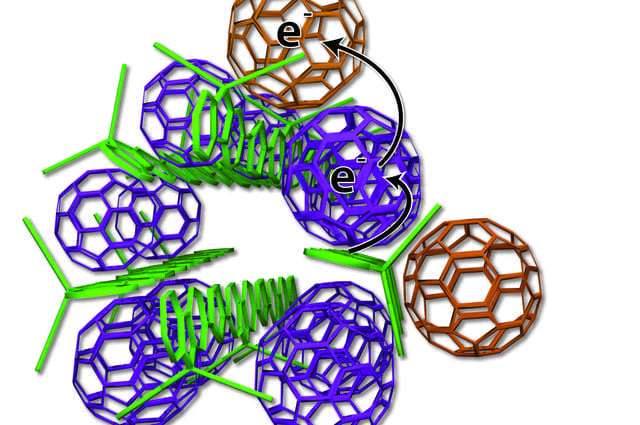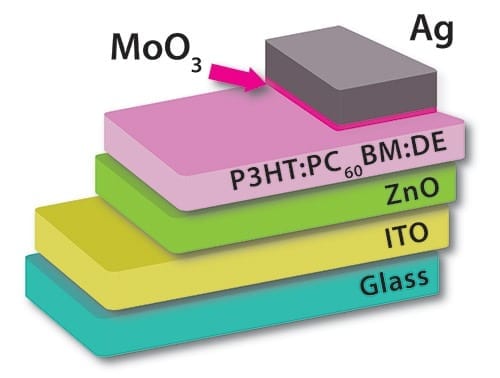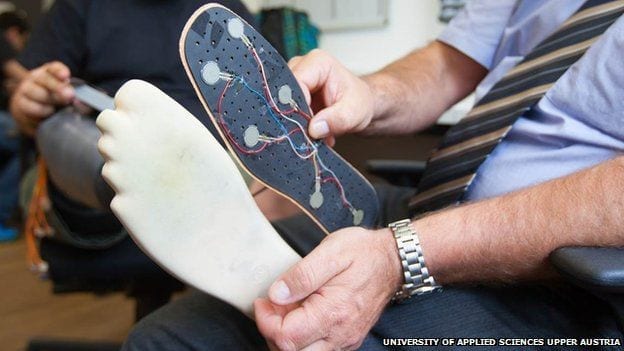
X-ray Studies at SLAC’s Synchrotron Pave the Way for Better Methods to Convert Sunlight to Electricity
A new material design tested in experiments at the Department of Energy’s SLAC National Accelerator Laboratory could make low-cost solar panels far more efficient by greatly enhancing their ability to collect the sun’s energy and release it as electricity.
A team of University of California, Los Angeles, scientists found that by assembling the components of the panels to more closely resemble the natural systems plants use to tap the sun’s energy, it may be possible to separate positive and negative charges in a stable way for up to several weeks compared to just millionths of a second – the current standard for many modern solar panels.
“In photosynthesis, plants that are exposed to sunlight use carefully organized nanoscale structures within their cells to rapidly separate charges – pulling electrons away from the positively charged molecule that is left behind, and keeping positive and negative charges separated,” said Sarah Tolbert, a UCLA professor of chemistry and one of the senior authors of the research. “That separation is the key to making the process so efficient.”
The team’s X-ray studies at SLAC’s Stanford Synchrotron Radiation Lightsource (SSRL), a DOE Office of Science User Facility, enabled them to see, at a microscopic level, which material design has the most ideal structure at the nanoscale for promoting this charge separation. The results are published in the June 19 editionof Science.
Plastic Panels Provide Low-cost Alternative to Silicon
To capture energy from sunlight, conventional rooftop solar cells use silicon, which can be expensive. Solar cells can also be made using lower-cost materials like plastics, but plastic cells are far less efficient — in large part because the separated positive and negative charges in the material often recombine before they can become electrical energy.
“Modern plastic solar cells don’t have well-defined structures like plants do because we never knew how to make them before,” Tolbert said. “But this new system pulls charges apart and keeps them separated for days, or even weeks. Once you make the right structure, you can vastly improve the retention of energy.”
A Better Recipe for ‘Spaghetti and Meatballs’
The UCLA-developed system is composed of strands of a polymer, the building block of plastics, that absorb sunlight and pass electrons to a fullerene, a spherical carbon molecule also known as a “buckyball.”
The materials in these types of solar cells are typically organized like a plate of cooked pasta – a disorganized mass of long, skinny polymer “spaghetti” with random fullerene “meatballs.” But this arrangement makes it difficult to get current out of the cell because the electrons sometimes hop back to the polymer spaghetti and are lost.
The researchers figured out how to arrange the elements more neatly – small bundles of uncooked spaghetti with precisely placed meatballs. Some fullerene meatballs are designed to sit inside the polymer spaghetti bundles and others are forced to stay on the outside.
The fullerenes inside the structure take electrons from the polymers and toss them to the outside fullerenes, which can effectively keep the electrons separated from the polymer for weeks. A series of experiments at SSRL and other studies confirmed the best arrangement of the polymer strands and buckyballs.
Successes and Next Steps
“When the charges never come back together, it becomes easier to get them out of the solar cell in the form of electricity,” said Benjamin Schwartz, a UCLA professor of chemistry and a co-author of the study. “This is the first time such long charge lifetimes have been shown using this type of material.”
Researchers found that the materials self-assemble into this ordered form when placed in close proximity. The new design is also more environmentally friendly than current technology, because the materials can assemble in water instead of more toxic organic solutions that are typically used.
“Once you make the materials, you can dump them into water and they assemble into the appropriate structure because of the way the materials are designed,” Schwartz said.
Read more: New Design Could Dramatically Boost Efficiency of Low-cost Solar Panels
The Latest on: Efficient low-cost solar panels
[google_news title=”” keyword=”efficient low-cost solar panels” num_posts=”10″ blurb_length=”0″ show_thumb=”left”]
via Google News
The Latest on: Efficient low-cost solar panels
- Energy-Efficient Upgradeson May 9, 2024 at 10:35 pm
If your energy costs are way too high, there are plenty of home upgrades that can help. These quick fixes don’t just make your space cooler, but they can help you save a pretty penny on those annoying ...
- Low-energy process for high-performance solar cellson May 7, 2024 at 3:50 pm
Finding reliable, eco-friendly power sources is crucial as our world grapples with increasing energy needs and the urgent call to combat climate change. Solar energy offers one solution, with ...
- How much do solar panels cost in 2024?on May 6, 2024 at 4:59 pm
so they generally cost more than smaller systems. If you have limited roof space, you might need to get more efficient (and more expensive) panels. Not all solar panels are created equal.
- The Average Cost of Solar Panelson May 2, 2024 at 5:00 pm
While solar panel costs are relatively affordable everywhere, your location will influence a number of factors that contribute to the overall cost and efficiency of your system. The average cost ...
- Here’s a low-cost way to make energy-efficient upgrades to your homeon April 29, 2024 at 11:46 am
Programs like this will help provide affordable financing options for homeowners to support our clean energy transition.”The loans, which will cover as much as $100,000, could be used for improvements ...
- How Much Do Solar Panels Cost In 2024?on April 15, 2024 at 11:19 pm
This higher efficiency comes at a cost, as most monocrystalline solar panels cost more ... panels allows you to harness the power of alternative energy at a low monthly rate.
- Switching to solar? We explain three main types of solar panelson April 13, 2024 at 1:31 pm
Their higher efficiency makes them better in low-light conditions ... by the NREL found that the average total cost of installing residential solar panels was $3.16 per watt.
- Georgia Solar Panel Incentives: Solar Loans, Efficiency Rebateson January 18, 2024 at 11:19 am
Georgia lacks statewide incentives, but abundant sunshine and the federal tax credit might make solar ... Free energy efficiency upgrades and ongoing energy savings HomePlus Loan Low interest ...
- How Much Do Solar Panels Cost in Georgia? (2024)on October 23, 2023 at 9:56 am
Polycrystalline panels have an intermediate cost and efficiency rating ... to keep excess production as low as possible. Alternatively, you can install a solar and battery system to store excess ...
- Most Efficient Solar Panels for 2024: New Record-Setting Panel Tops the Liston May 26, 2023 at 9:55 am
High-efficiency solar panels typically cost more than lower-rated ones, so making the best choice becomes a matter of balancing your financial goals with what your preferred installer offers and ...
via Bing News










